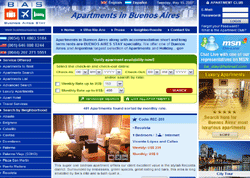Where is Buenos Aires? Find Buenos Aires on a map
Where is Buenos Aires? Find Buenos Aires on a map
The city of Buenos Aires is located at the north-eastern edge of the flat plain known as the Pampa that occupies Argentina’s heartland. Buenos Aires is a city that fiercely holds on to its colonial past and is the most ‘European’ city in South America. It is situated on the South Atlantic coast of South America at the point where the Paraná River delta widens to meet the RÃo de la Plata (River Plate). Buenos Aires is on the southern shore of the Rio de la Plata with Colonial, Uruguay on the opposite side of the estuary, coordinates and satellite link - . The eastern and northern limits of the metropolitan area are defined by the RÃo de la Plata, and the city's most prominent physical characteristics are the numerous small rivers that flow through its periphery. The centre of Buenos Aires city occupies a bluff overlooking the RÃo de la Plata and to the south is another river, the Riachuelo, the banks of which mark the other high land in the city. The rest of the city is laid out on the floodplains of the rivers.
Want to see some great maps of Buenos Aires try these links:
http://www.tandilnet.com/Turismo/plano.html
http://travel.yahoo.com/p-map-191502061-map_of_buenos_aires_df-i
The metropolitan area is divided into the Federal District, established in 1880, and the surrounding suburbs, or partidos. The Federal District contains less than one-third of the population of the metropolitan area, a proportion that shrinks as the suburbs continue to attract industry and residential communities. The city is divided into districts that coincide mostly with the old neighbourhoods, or barrios. The centro is built on the original colonial foundation. It has narrow streets laid out at 90-degree angles to form a grid pattern. This rectilinear pattern holds for more than 20 square blocks, an area that defined the limits of the city until the late 19th century. Since that time, expansion has been less planned, and the pattern of streets is less regular. The limits of the Federal District are marked by the Riachuelo River and the Avenida General Paz, which was opened in 1941 after nearly a decade of construction.
The modern city developed outward from the Plaza de Mayo, a historic square flanked by the Town Hall (Cabildo), which dates from the 18th century, and the Government House, commonly called the Casa Rosada. The Casa Rosada faces west, up the broad Avenida de Mayo, which leads directly to the Plaza del Congreso and the National Congress building, built in the early 20th century. All distances on national highways are measured from the zero-kilometre point in the small square across from the building. The Plaza de Mayo is also the site of the Metropolitan Cathedral, another monumental building from the colonial period. The rest of what remains of colonial Buenos Aires lies mostly south of the plaza, in San Telmo, or Barrio Sur, which, after nearly a century of neglect and decay, has been restored and gentrified.
Andrew Rae McCance
Buenos Aires Stay
